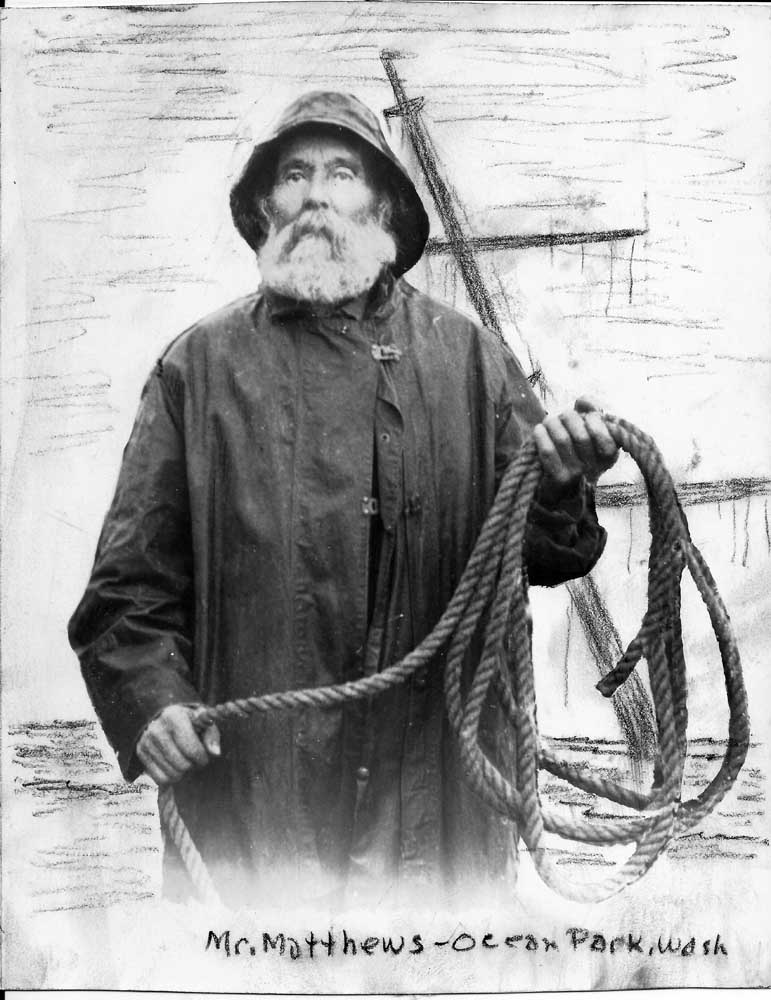Saints or Sinners? Characters of Pacific County: Thanks to him we have a legacy of historical photos
Published 10:38 am Thursday, September 5, 2024

- S.A. Matthews as the “Old Mariner.” Matthews, a carpenter, was noted for his sense of humor. He was talked into posing in a sou’wester for this photograph by Charles Fitzpatrick of Ocean Park. Later, artist Joe Knowles used the photo to paint Matthews standing at the helm of a sailing ship in a raging storm.
Charles Fitzpatrick 1884-1971
Charley Fitzpatrick was an affable, slightly built (“skinny” some said) bachelor who he arrived on the Peninsula in 1927 for a visit with his sister and brother-in-law, Anna and Hans Jacobsen of Ocean Park. They urged him to stay and he did — perhaps because Anna was a fabulous cook, a big plus to an unmarried man. Or more likely, he found the area a visual paradise, for Charley was an artist by temperament and a photographer by trade.
He had begun his career in the Sacramento area of California in 1908 and his artistic skills were well-honed by the time he arrived on the North Beach Peninsula. Here, the subject-matter seemed limitless. He was fascinated by the landscape, by the people and industries of the region, and by the history as told to him by the old-timers. He built his little studio behind the Jacobson’s house and settled in.
Charley was not only interested in people and the stories they had to tell, he was interested in creating his artwork so that they could acquire it — hang it on their walls, keep it as treasured mementos, send it in postcard form to loved ones far from this beloved corner of the word. He took portraits of people — sometimes encouraging a particular costume as in the portrait of Art Matthews dressed in slicker and sou’wester as “The Old Mariner.” That particular image became the “logo” for the Pacific County Historical Society’s quarterly magazine, The Sou’wester created in 1966; it is still in use today.
Not only are Charley’s photographs a record of this area from a time when change was still happening gradually, but it was also a time when much of the past was still visually apparent. Outhouses and barns, wagons and buggies, kerosene lamps and wood stoves were still in use. Transitions to “modern living” were gradual and the amenities such as electricity and telephone service were still considered somewhat “newfangled and not always reliable. If Charley didn’t capture some of these day-to-day phenomena with his camera, he was likely to draw it with pen and ink.
He became especially well-known for his images of shipwrecks which, in those days before modern aids to navigation, were an all-too-common occurrence along the 28 miles of the weather-beach. He collected images and stories about historic wrecks and closely monitored his radio in order to be among the first at the scene of an incoming disaster.
Too, Charley was community-minded. When Trondsen’s store and an adjoining building burned to the ground n 1937 — the entire block where Jack’s Country Store is located now — Charley was instrumental in establishing Ocean Park’s first fire department and in obtaining their first makeshift fire truck. Some years later, when Oysterville was gearing up for its centennial celebration, Charlie worked with a group of old-timers to draw a composite map of Oysterville in its heyday, 1880-1890 — now in the form of a bronze plaque in the Oysterville Churchyard.
When Trondsen’s store and an adjoining building burned to the ground n 1937 — the entire block where Jack’s Country Store is located now — Charley was instrumental in establishing Ocean Park’s first fire department and in obtaining their first makeshift fire truck.
Late in life, Charley and a spinster neighbor, Miss Martha Yenne, became romantically involved and got married. He took less and less interest in his photography from that time and soon sold his collection of negatives to Lucille Wilson. Lucille had recently opened a new restaurant, The Ark, at the Nahcotta Dock with a small gift shop alongside. She had Charley’s negatives made into postcards and sold them “by the scores!” Later, her mother Beaulah Wickberg also sold the Fitzpatrick cards in her Ocean Park shop.
Not too long after their marriage, Charley and Martha moved “to the city” from the Peninsula – Martha’s choice it was said, though Charles was not in good health by then and she felt he needed to be closer medical attention. He died in 1971 at age 87 at a Vancouver Hospital. One of his cameras and some of his prints were rescued from his Ocean Park house by Jack Downer when it was being demolished.
But even more importantly, Charley Fitzpatrick’s photographs and sketches can be seen throughout the Peninsula and beyond — a legacy seldom equaled by most residents, no matter how ‘connected’ they are to this special place.









